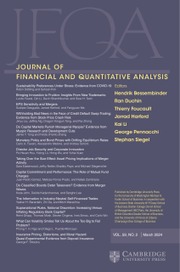Article contents
Pricing Two Heterogeneous Trees
Published online by Cambridge University Press: 01 June 2011
Abstract
We consider a Lucas-type exchange economy with two heterogeneous stocks (trees) and a representative investor with constant relative risk aversion. The dividend process for one stock follows a geometric Brownian motion with constant and known parameters. The expected dividend growth rate for the other tree is stochastic and in general unobservable, although there may be a signal from which the investor can learn about its current value. We find that the equilibrium quantities in our model significantly depend on the information structure and on the level of risk aversion. While an observable stochastic drift mainly makes the economy more risky, a latent expected growth rate process with learning significantly changes the equilibrium price-dividend ratios, price reactions to dividend and drift innovations, expected returns, volatilities, correlations, and differences between the stocks. These effects are the more pronounced the more risk averse the representative investor.
Information
- Type
- Research Articles
- Information
- Journal of Financial and Quantitative Analysis , Volume 46 , Issue 5 , October 2011 , pp. 1437 - 1462
- Copyright
- Copyright © Michael G. Foster School of Business, University of Washington 2011
References
- 13
- Cited by

